Invasive evaluation determined limits of resection
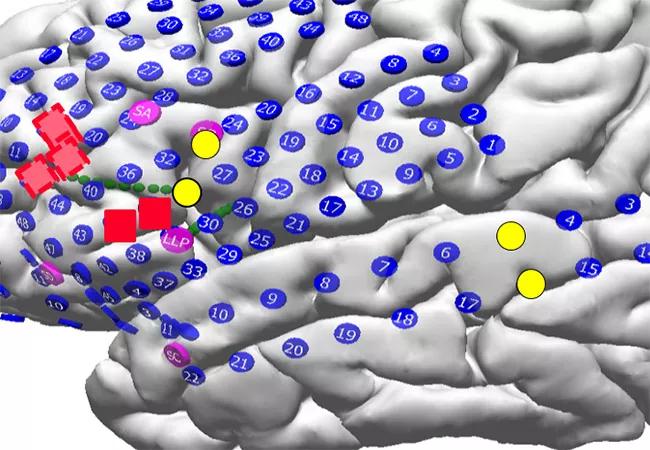
By Dileep Nair, MD, and Juan Bulacio, MD
Cleveland Clinic is a non-profit academic medical center. Advertising on our site helps support our mission. We do not endorse non-Cleveland Clinic products or services. Policy
For patients with drug-resistant epilepsy and subtle findings on MRI, invasive electrodes are often required for developing a strategy for epilepsy surgery. This is especially likely when eloquent cortex is nearby. How should we choose from the available invasive techniques to optimize outcome in individual cases?
A 29-year-old man presented to Cleveland Clinic’s Epilepsy Center with drug-resistant epilepsy. Seizures began at age 16 as bedwetting episodes. He took antiepileptic medications for three years, then stopped; two years later, seizures recurred. Witnesses described his seizures as periods of staring — with decreased responsiveness, difficulty speaking and hand automatisms — occurring three times daily. In addition, about once a month, a seizure would evolve into a generalized tonic-clonic convulsion. He had tried multiple antiepileptic medications over the years, without relief.
EEG was performed, which showed repetitive spikes in the left frontocentral region interictally.
Ictal EEG showed a burst of fast activity in the same region, then abrupt generalization involving many electrodes. Thirty seconds later, the seizure ended with attenuated activity in the left hemisphere more than the right.
The patient had a normal neurological examination and no epilepsy risk factors. An MRI performed earlier was interpreted as normal. However, a second reading of the same MRI at this time revealed very subtle findings.
Focal cortical dysplasia is an important cause of drug-resistant surgically remediable epilepsy, and it may be subtle or invisible on MRI. Often when re-reviewing cases with MRIs initially read as normal, it is possible to find abnormalities when a search is based on other factors in the case.
We had the patient undergo coronal FLAIR imaging, which showed hypointensity in the inferior frontal gyrus on the left side extending from the cortex to white matter.
Axial FLAIR imaging revealed signal changes in the left anterior frontal lobe, in the pars orbitalis. A lesional track communicating from the abnormal gray matter to the ventricle surface indicated a transmantle malformation of cortical development — an abnormality with high epileptogenic potential and the likely cause of the patient’s seizures.
Because of the lesion’s possible proximity to Broca’s language area, functional MRI was performed next. Results showed activation for word generation, listening and rhyming overlying the area of dysplasia.
Because invasive evaluation is costly and carries significant risk, it should be undertaken only to confirm or reject a hypothesis and help determine a course of action, not to fish for unexpected results or provide additional evidence for a decision that is already incontrovertible.
When invasive evaluation is decided upon, the choice of techniques must be individualized for every case. Subdural electrodes offer close spatial resolution of the epileptogenic zone in relation to the eloquent cortex, whereas stereotactic depth electrodes enable more-precise recording from regions below the cortical surface. Despite traditional thinking, inserting depth electrodes does not carry a greater risk of complications than subdural evaluation; in fact, with good technique, the opposite may be true.
It was recommended that the patient undergo invasive testing to better determine the lesion’s precise location in relation to language centers and to delineate the area of maximum possible resection.
The area of the lesion was covered by a subdural grid, and two depth electrodes were placed to derive information of the deeper structures at the site of the lesion.
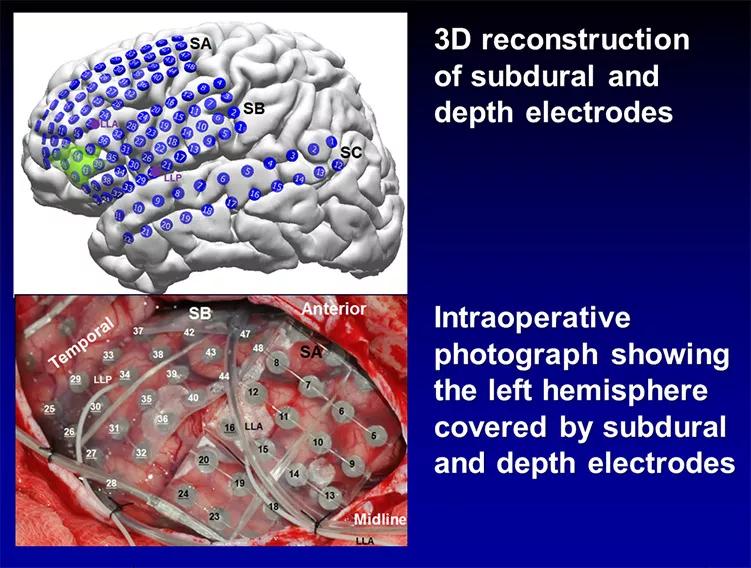
Electrocorticography showed repetitive spikes in the left inferior frontal region interictally and ictally.
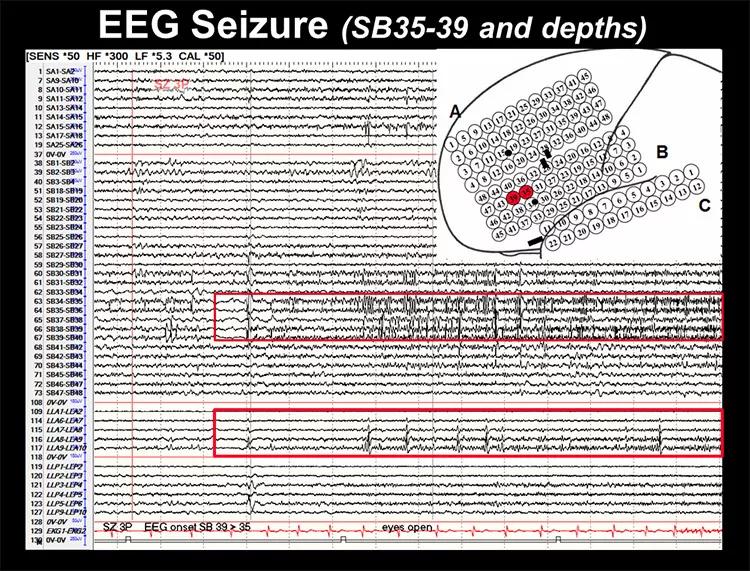
Propagation appeared restricted, and the deeper probes appeared more flat. Seizure activity was evident on EEG even without clinical signs.
Continuous repetitive discharges is the most significant and characteristic electrocorticographic finding of focal cortical dysplasia. If areas of continuous repetitive discharges are left behind in surgery, the operation is more likely to fail.
Sublobar resection of the left pars orbitalis was undertaken. The resection was limited to the area defined as abnormal on MRI and epileptogenic on subdural EEG, while sparing language areas identified by cortical stimulation (see map below). Although a common dogma in neurosurgery is to stay at least 1 cm away from eloquent cortex, this is not necessarily justified. In this case, clear anatomical boundaries (the sulci) defined the extent of the language areas and allowed the surgeon to resect to their limit.
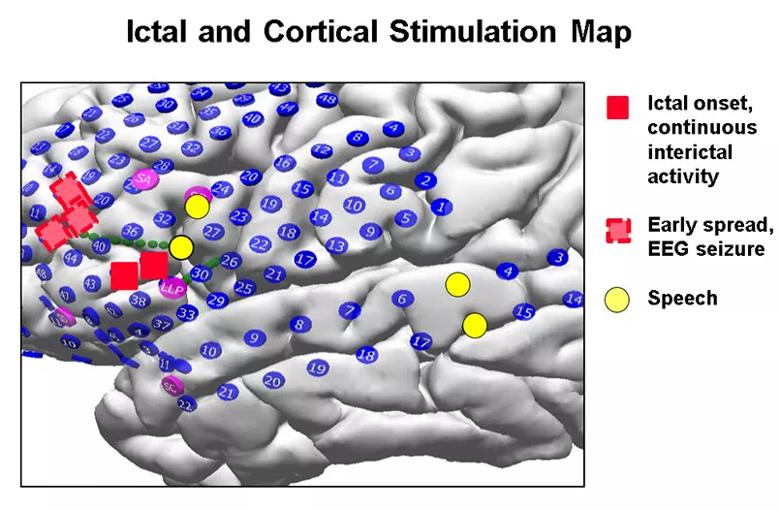
Pathology of the resection showed type II cortical dysplasia, with focal cortical architectural disorganization, dysmorphic neurons and balloon cells.
One year later, the patient has been seizure-free since surgery and without language deficit. His EEG shows no epileptiform discharges.
This case highlights at least two key teaching points and takeaways:
To view a webcast of this and nine other epilepsy cases in the “Hot Topics in Epilepsy for Children and Adults” CME-certified webcast series, visit www.ccfcme.org/EpilepsyCME. This activity has been approved for AMA PRA Category 1 Credit™.
Dr. Nair is Section Head of Adult Epilepsy and Dr. Bulacio is a staff epileptologist, both in Cleveland Clinic’s Epilepsy Center.
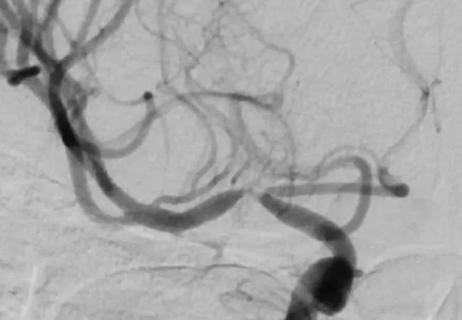
When specialized surgery makes sense for moyamoya syndrome

Multilevel cervical fusion restores function in an athletic 78-year-old

Case study underscores the imperative for thorough evaluation with SEEG
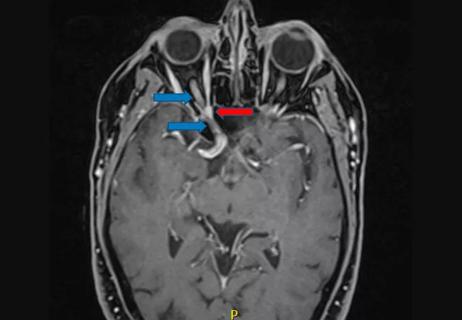
Schwannoma of the lacrimal nerve threatened right eye blindness

Case report demonstrates utility in a brain-injured patient

Partial resection plus radiation leads to good outcome from an unpredictable tumor

Diagnosis and treatment of rotational vertebrobasilar insufficiency syndrome
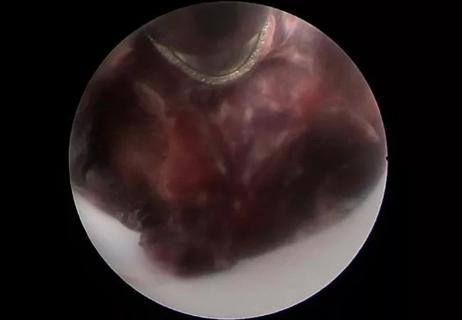
First reported case expands use of minimally invasive techniques